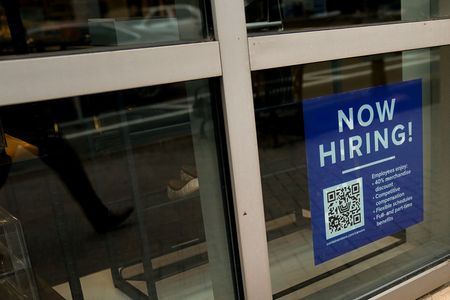By Lucia Mutikani
WASHINGTON (Reuters) – U.S. job openings rose in May after posting outsized declines in the prior two months, but the trend remained consistent with an easing in labor market conditions that could pave the way for the Federal Reserve to cut interest rates this year.
The Job Openings and Labor Turnover Survey, or JOLTS report, from the Labor Department on Tuesday showed there were 1.22 vacancies for every unemployed person in May, unchanged from April and the lowest vacancy-to-unemployment ratio since 2021. April’s ratio previously had been estimated at 1.24. The ratio is now not too far from its average of 1.19 in 2019.
“The data are pointing to an ongoing normalization between supply and demand for labor,” said Rubeela Farooqi, chief U.S. economist at High Frequency Economics. “From a policy perspective, the Fed’s challenge going forward will be to keep rates at a level that not only helps keep inflation in check but also prevents unnecessary damage to the labor market.”
Job openings, a measure of labor demand, rose 221,000 to 8.140 million on the last day of May, the Labor Department’s Bureau of Labor Statistics said. Data for April was revised lower to show 7.919 million unfilled positions instead of the previously reported 8.059 million. Economists polled by Reuters had forecast 7.910 million job openings in May.
Unfilled positions peaked at a record 12.182 million in March 2022. They have declined by 1.2 million over the year.
There were an additional 117,000 job openings in state and local government, excluding education. Vacancies increased 97,000 in durable goods manufacturing and rose 37,000 in federal government. But unfilled jobs decreased 147,000 in accommodation and food services, while private educational services saw a 34,000 reduction in job openings.
A gradually rebalancing labor market and subsiding inflation are drawing the U.S. central bank closer to beginning its easing cycle, with financial markets still eyeing the first interest rate cut in September. The Fed has maintained its benchmark overnight interest rate in the current 5.25%-5.50% range since last July. The central bank has hiked its policy rate by 525 basis points since 2022 to stamp out inflation.
Fed Chair Jerome Powell said on Tuesday that policymakers wanted to see more evidence that inflation was subsiding, before lowering borrowing costs.
Stocks on Wall Street were mixed. The dollar was steady against a basket of currencies. U.S. Treasury prices rose.
HIRES RISE
Job openings decreased 119,000 among businesses with one to nine employees. Small businesses have been the biggest drivers of job growth and the decline portends slow employment gains ahead. But unfilled jobs increased 87,000 among companies with
10 to 49 workers. There were also more job openings in medium-sized firms as well as large establishments.
The decline in vacancies was in the South, which has experienced strong job gains. Job openings increased in the Midwest, Northeast and West.
The job openings rate rose to 4.9% from 4.8% in April. Hires increased 141,000 to 5.756 million, lifted by professional and business services and construction. But hiring declined in retail trade, accommodation and food services as well as manufacturing. Hires are down by 415,000 over the year. The hires rate rose to 3.6% from 3.5% in April.
Layoffs rose 112,000 to 1.654 million, amid job losses in professional and business services, leisure and hospitality as well as other services. But there were fewer layoffs in manufacturing. The layoffs rate was unchanged at 1.0% for a third straight month.
Layoffs were mostly in businesses with one to nine workers and establishments with 250 to 999 employees. They were concentrated in the South.
With the labor market not as tight as in prior years, fewer workers are job-hopping.
The number of people quitting their jobs was little changed at 3.459 million, though there were more resignations in the trade, transportation and utilities industry as well as financial activities and professional and business services. Fewer workers quit in the leisure and hospitality sector.
The quits rate, viewed as a measure of labor market confidence, was unchanged at 2.2% for the seventh consecutive month. A steady quits rate points to moderate wage pressures ahead, which bodes well for the overall inflation outlook.
A recent Bank of America Institute survey found that job-to-job moves remained at levels above 2019 rates. It, however, noted “the pay raises people are getting for job changes has slipped a little below 2019 levels, which might suggest the balance of bargaining power has shifted somewhat away from workers, particularly for middle- and higher-income job changers.”
“The labor market for now is healthy enough to allow the Fed to wait for more confirming data that inflation is back on a path to 2% before lowering interest rates,” said Nancy Vanden Houten, U.S. lead economist at Oxford Economics.
(Reporting by Lucia Mutikani; Editing by Andrea Ricci)





